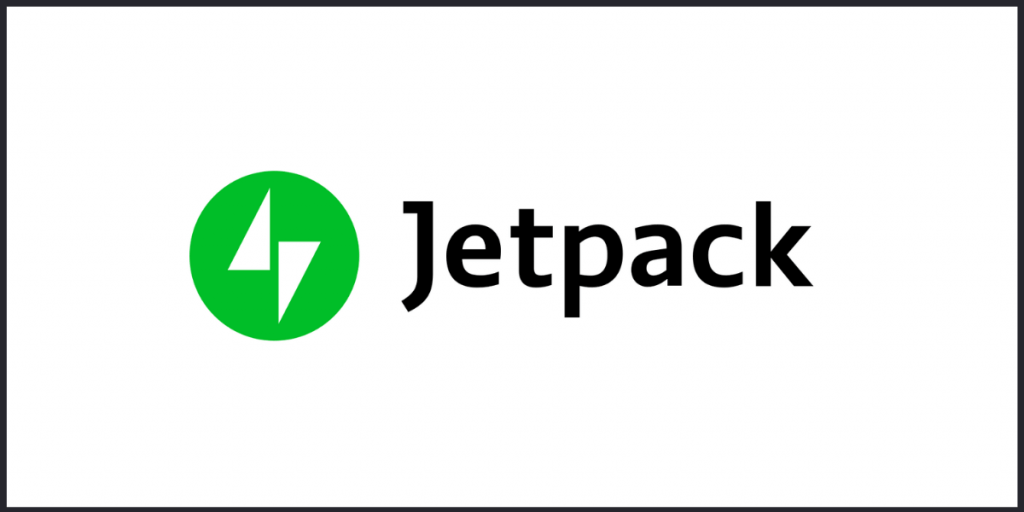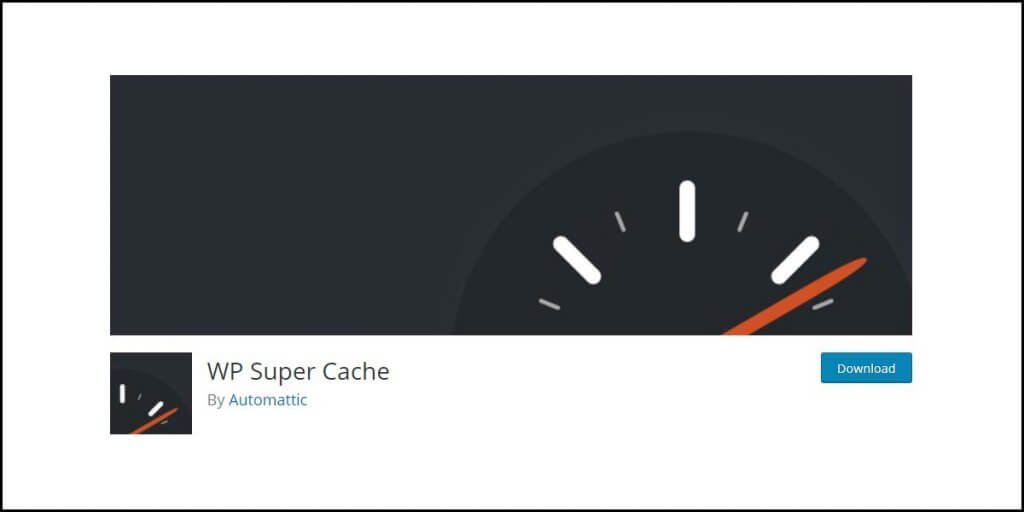Before I start with the WP-Optimize review, I will like to tell a few things that you need to remember properly.
It is needless to say, optimizing a WordPress site for speed has become a headache for every webmaster who own and runs a WordPress-powered site. Well, there is no way out! Google wants every site to be lightning fast. The problem with sites powered by WordPress is that the core CMS is a beast and takes a lot of time to load.
Things get worse when you start adding plugins, images, videos, third-party scripts, web fonts, etc. But what else can you do? You cannot live without those things. You will need plugins like SEO plugin, forms plugin, and more. Your blog posts will have images and/or videos.
All these things add to web page weight and slow it down!
That doesn’t mean you cannot build a fast website using WordPress. There are many optimization tips and tricks that you can follow and achieve incredible speeds. One of those tricks is to use a proper caching plugin, and yet another trick is to ensure that your database remains optimized.
I am a big proponent of LiteSpeed Cache, but that doesn’t mean you have to stick with that. There are other good options available. One of them is the WP-Optimize plugin that brings simple and yet effective caching and database optimization solution that can speed up your website.
So, let’s begin with the WP-Optimize review, shall we?
What is WP-Optimize plugin?
WP-Optimize is a simple caching and database optimization plugin. It was initially released only as a database optimization plugin, but as time passed, the plugin evolved into a complete optimization package that works with a three-pronged approach.
What does it do?
The plugin does three things:
- Cleans up the database
- Compresses images
- Caches the static files of a site
Properly performing these three tasks can lead to massive speed bumps in website speed. A fast website can lead to better search engine rankings!
WP-Optimize Plugin Walkthrough
The WP-Optimize plugin is extremely easy to use. Once you install and activate the plugin, you will be taken to the general settings tab first where you can activate or deactivate a few things. Here is what the general settings window looks like:

The first two options in the General settings segment will allow you to allow or disallow quick access to WP-Optimize and caching menu through the admin bar. I will suggest that you enable both. This will ensure that you don’t have to visit the dashboard every time you need to access the settings.
The next two options will allow you to enable or disable trackbacks and comments on previously published posts. However, the trackbacks and comments that already existed before disabling them will not be removed. They will stay!
This can be extremely useful if you have hundreds of posts and you don’t want to manually change all the settings.
The next option is to set a destination for logging. WP-Optimize will keep logs. If you want those logs to be stored in a specified destination, you can do that from here.
Finally, if you are somehow not happy with the settings of WP-Optimize and you want to start over you can wipe all settings using a single click.
You can deal with these settings later by accessing the General settings from Dashboard >> WP-Optimize >> Settings.
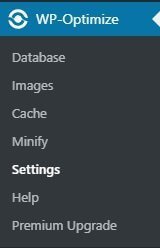
Database Optimization
The first and core function of WP-Optimize is database optimization. As I said earlier, the plugin was developed for optimizing database. Caching and other features came in later.
To access database optimization features, you need to visit Dashboard >> WP-Optimize >> Database.
This is where you will find three tabs:

The first tab is where you will get all the options for optimizing your WordPress site’s database. Here is what you will see:

You don’t have to worry about what these options actually do. All the options you find here can be selected and you can run the optimization safely. However, when it comes to removing unapproved comments, I will suggest that you first approve all the comments that you want to keep. Selecting that option will definitely remove every comment that has been put on hold for manual approval even if those comments are not spam comments.
Also, some people prefer to keep a few post revisions available all the time so that they can revert whenever necessary. I, for instance, don’t case about post revisions, because I ensure that every post goes through strict scrutiny before being published. This means that I make sure that the post has everything that should be there.
In case of future updates, I just go ahead and add the updated information. That’s all! But if you want to keep post revisions, unselect it and then run the optimization.
Good thing is that you can either select everything can run optimization at once, or you can run optimization for each option separately.
Before you run any optimization, I will suggest that you take a complete backup of your website. This way you will have a copy of your website available in case something goes wrong during the optimization process.
The Tables tab will show you all the tables that are present in your database and it will also try to tell you which plugins uses specific tables. That’s a good thing because in case you are removing a plugin and want to ensure that everything from the database is removed, you can identify the tables and drop them manually from phpMySQL.

Honestly, the Tables tab will not give you options to perform any action. It will only give you some information that you can use to perform manual actions (if required).
However, if you upgrade to the premium version of the plugin, you can optimize individual tables.
The next tab is the Settings tab. This tab is different from the General settings tab. This is where you can set automatic database optimizations and even decided how much of previous data should the plugin retain. It is always a good idea to retain at least 2 weeks of data.

Do not forget that the scheduled clean-up is a beta feature, which means that there can be bugs. I will recommend that you don’t turn this ON. Instead, run optimizations manually.
Image Optimization
Image optimization options can be accessed from Dashboard >> WP-Optimize >> Images. This segment will allow you to compress the images you upload to your site. If there are existing images, it can optimize them too.
The image optimization (compression) feature currently uses reSumsh.it services. That’s a third-party service. The developers are working on their own premium image compression service.
Once you get into the Images tab from the left menu of your WordPress dashboard, you will find three tabs. The first tab is available in the free version, the remaining two tabs are available only for premium users.

This is what I didn’t like! You can actually get lazy-loading for free with various plugins, and even a few theme integrate lazy-loading by default. So, the idea of keeping lazy-loading as a premium feature was totally stupid.
The only available feature for the free version is the image compression service. There are a few settings that you can use. Here is what you will find here:
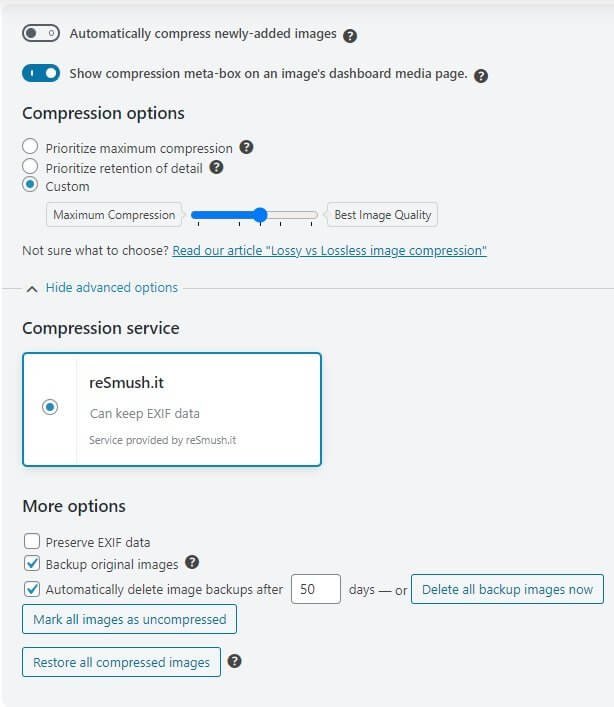
There is absolutely nothing new in what you find here. These are the usual settings for any image optimization plugin that you may already be using.
Personally, I don’t like a plugin optimizing images for me. I prefer doing that myself. You can read my guide on how to optimize images.
As far as dealing with unused images and lazy-loading is concerned, you can simply remove them if you have a premium version. If you don’t have a premium version, you can manually remove unused images by deleting them manually from the server. The easy way to find unused images is to go to Media Library and look for images that are not in use.
For lazy load option, you can use separate plugins that allow lazy-loading in addition to image optimization. I prefer using LiteSpeed Cache that allows lazy-loading and even allows using low-quality image placeholder, that significantly improves page load speed and removes CLS issues caused by image lazy-loading.
Caching Options
WP-Optimize has caching options available. The caching settings are pretty straight-forward and simple to understand. In case you are a newbie, the ease-of-use will thrill you.
You can access the caching options through Dashboard >> WP-Optimize >> Cache.
Once you get into the caching segment, you can find 5 different tabs. This is what you will see:
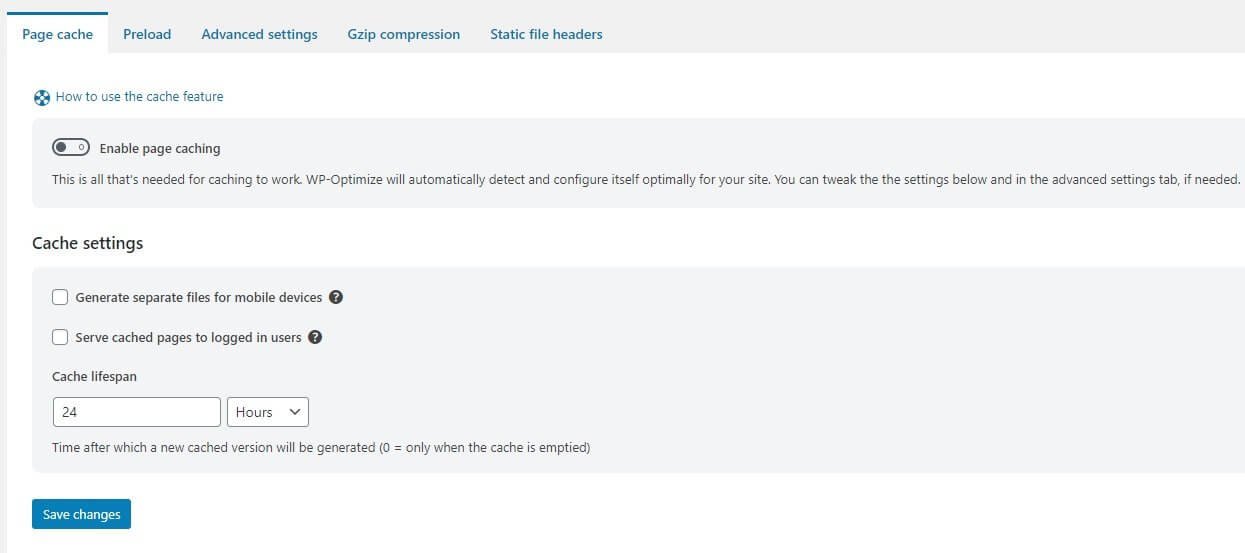
The first tab is Page Cache. This is where you should enable page caching. In cache settings, enable caching for mobile devices and disable caching for logged in users. If you enable cache for logged in users, they may see stale copies. This is not helpful if you are building some form of membership site. So, if your site doesn’t have a membership option, you, as an administrator, can see cached pages. This may hamper your progress with publication and updates.
The next tab is Preload tab where you can preload cache files before a user actually opens a page.
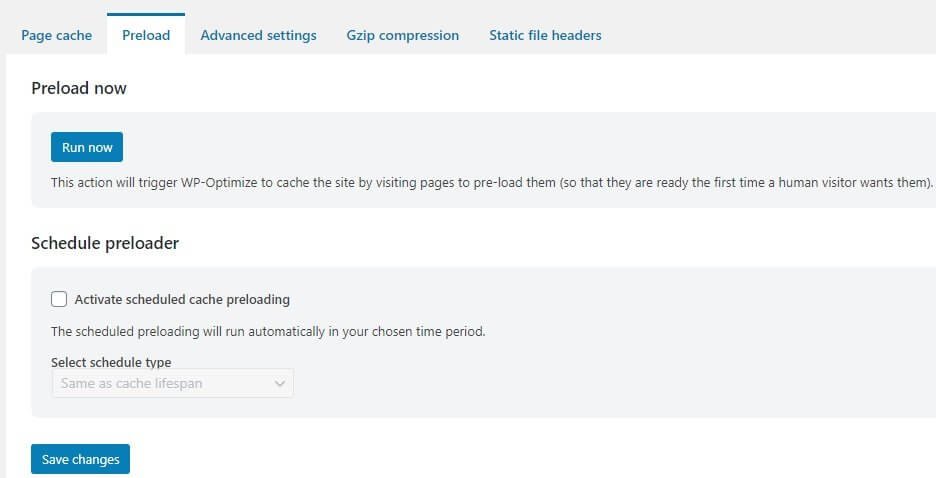
If you are on a shared server, you should not be doing this. Preloading cache files can improve user experience only if your server can handle such extra task. Usually, a shared server is not powerful enough. So, enabling preload can likely make your website sluggish, or even inaccessible.
Use this only if you have dedicated resources at your disposal.
The next tab is the Advanced settings tab where your can determine which pages should not be cached.
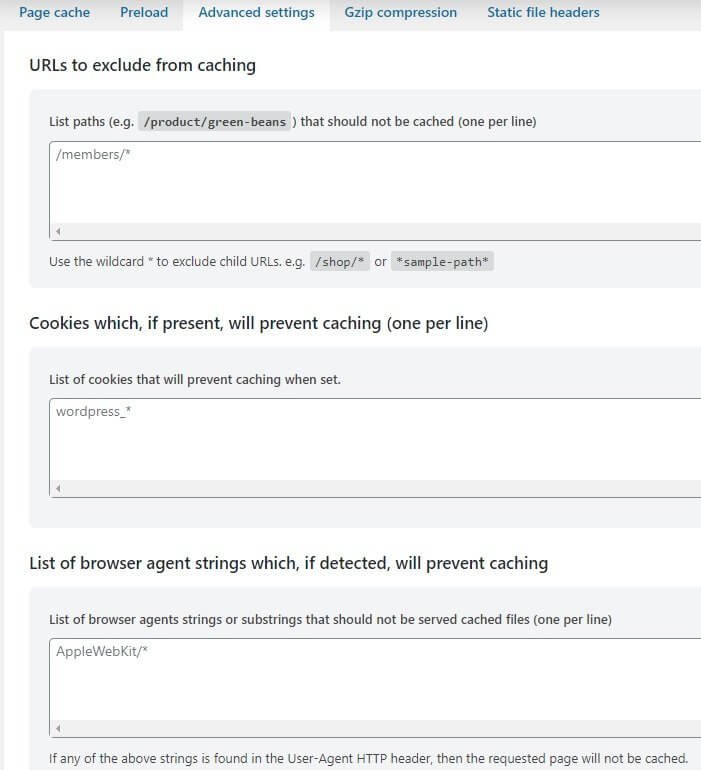
You can also determine which cookies should not be cached. Additionally, you can list all browser agent strings for which you don’t want caching.
Usually, this segment, as the name suggests, is for advanced users. If you have a simple blog, avoid these settings. If you have an advanced site, but you have no idea about what to do here, it is better you hire a developer to get the settings. You can also ask for help from the plugin developers if you have a premium version.
Gzip Compression is the next tab where you can enable Gzip compression. This is helpful, and you should enable it.

In case you are using CloudFlare and you have brotli compression enabled, you need not worry about this. You can still enable it, but having brotli compression on simply nullifies the need for using Gzip compression.
The final tab is Static File Headers tab. This tab essentially allows you to enable browser caching. I think the developers should have used the name “browser cache,” but whatever!

Enable this and the default value of 28 days is perfectly fine. You should set it to a small value if your website’s design changes frequently. If you don’t want to change your website’s design for a very long time, you can set it to a higher value (even 365 days is fine)!
Minify Options
Minification of HTML, JavaScript, and CSS files is a good choice. You should do that, as it can dramatically reduce the page load time.
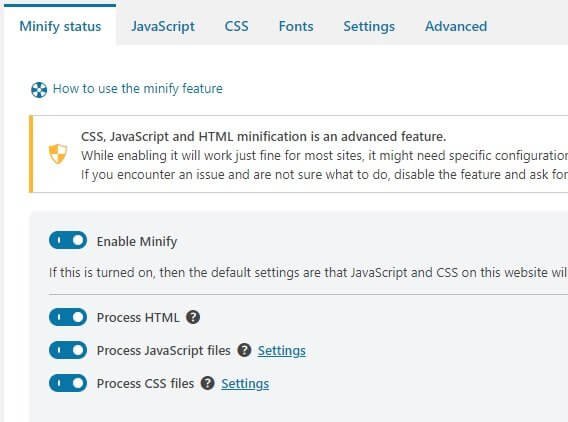
Once you enable minify, additional settings (extra tabs starting from the JavaScript tab) will become available.
On the first tab, set everything to minify. Once you have done that, move on to the JavaScript tab. This is where you will see this:

Starting from the top, enable JS minification. Enable merging with caution. If something on the frontend is breaking, disable merging.
Enable the third option (each JS in its own block) only if minification and merging is causing error. If enabling is not fixing the error, disable merging. Keep minification ON, because that isn’t going to cause error. That will only remove some unnecessary characters.
You can also selectively choose JavaScripts and prevent minification or merging. Finally, you should selectively defer JS. Don’t defer all JS files. Some JS files are necessary for proper rendering of the site. Deferring all JS files can break your site.
The next tab is the CSS tab where you will get advanced settings.
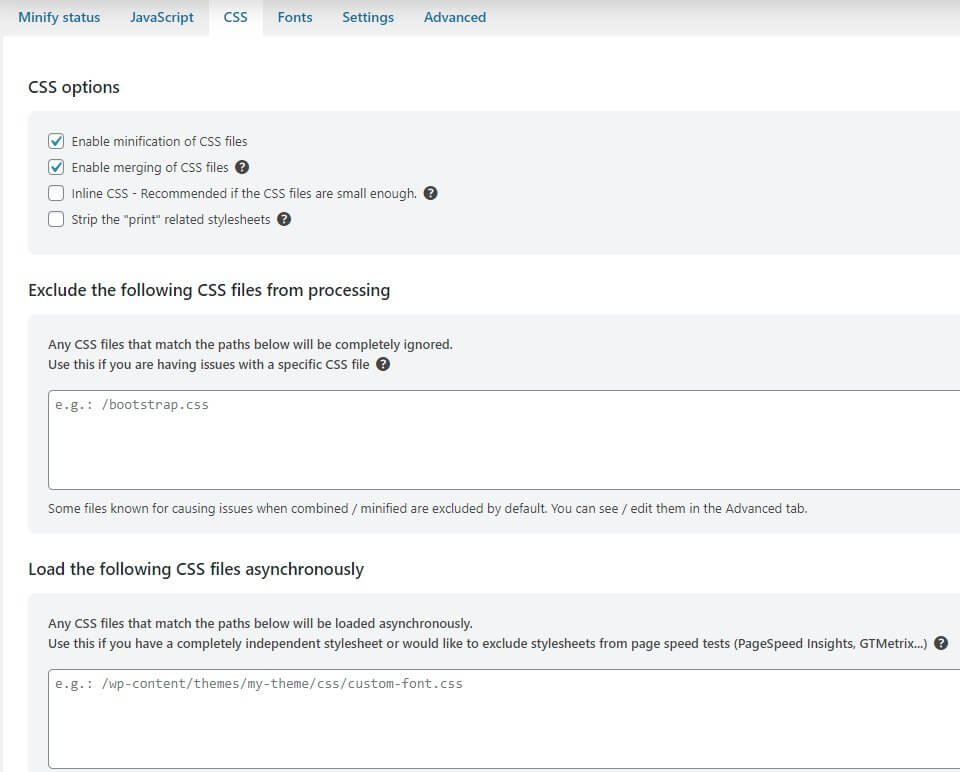
Minification of CSS is fine. Merging can cause issues and break your site. Use with caution and check everything thoroughly. DO NOT inline CSS. That’s never a good idea, and doing so with minification and merging enabled can break your site. Also, don’t strip print related stylesheets. Certain themes need that. If you are enabling it, check your site thoroughly.
Similar to the options of JS, you can selectively prevent CSS files from minification and merging. You can also load CSS files asynchronously. I will not recommend doing that. CSS, by definition, is render-blocking. Trying to load CSS files asynchronously will lead to what is called FOUC (Flash of unstyled content) and that gives rise to bad user experience. Don’t do that, especially when Google’s new algorithm update is focusing on user experience.
I will recommend that you don’t use any page-builder plugin because they use a lot of CSS (bloated CSS) and trying to merge them or asynchronously loading them WILL break your site. So, it is better you keep things simple.
The Fonts tab is where you can decide how your website handles Google Fonts and Font Awesome. Well, I don’t recommend using either. They can add extra weight to your site.

If you do want to use Google Fonts, I will recommend that you localize the fonts using a plugin called OMGF (Optimize My Google Fonts). Not only can OMGF help you to load Google Fonts locally, but also ensure that you are not violating GDPR, because the fonts will load from your server and Google will not be logging user IP.
The Settings tab has some default options already selected. Leave them as is! They are perfectly fine!

Finally, you will have the Advanced tab where you can find the list of all JS and CSS files that have been processed. You can also enable debug mode if you are a developer and you want to debug issues caused by the plugin.

The one option I like here is ‘Default Exclusions.’ You should enable this. This will ensure that WP-Optimize will exclude a few files that are known to cause issues when minified or compressed.
That’s all!
WP-Optimize Pricing
There is a free version of the plugin, but if you want, you can always purchase the premium plan. The premium version will give you a few extra optimization features. The price is quite reasonable.
You need to pay $39 per year (yes, you need to renew) if you intend to use it on 1 or 2 sites. For using it on up to 5 sites, you need to pay $59 a year. For an unlimited site license, you need to pay $149 a year.
Should You Use WP-Optimize?
Yes, you should use WP-Optimize, especially if you are not using LiteSpeed Cache (on a LiteSpeed or OpenLiteSpeed server).
I will always recommend LiteSpeed cache which has all features that WP-Optimize gives (and more), but also allows you to use it in conjunction with QUIC.cloud CDN. What else, LiteSpeed cache is completely free!
In case you don’t want to use LiteSpeed cache, my tests showed that WP-Optimize is the next best caching plugin (in terms of the results delivered).
You can always go through my entire article on best WordPress cache plugins.
WP-Optimize is simple and easy to use. There are no complex settings to deal with, and it does deliver great speeds! However, if you really want your website to be super-fast, I will suggest you switch to a server that has LiteSpeed web server and use LiteSpeed cache. Together, they can do wonders!
